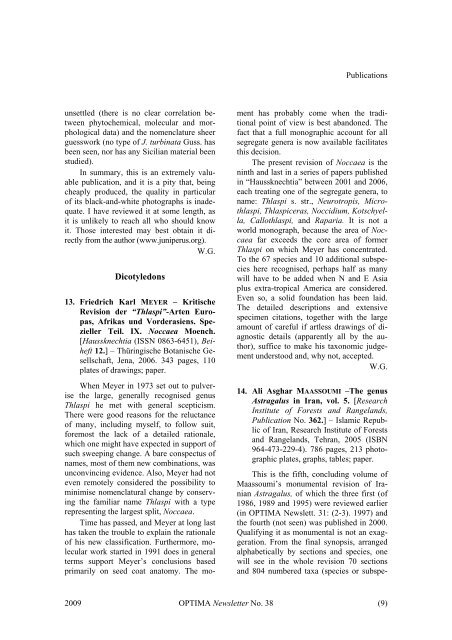OPTIMA Newsletter 38
OPTIMA Newsletter 38
OPTIMA Newsletter 38
You also want an ePaper? Increase the reach of your titles
YUMPU automatically turns print PDFs into web optimized ePapers that Google loves.
unsettled (there is no clear correlation between<br />
phytochemical, molecular and morphological<br />
data) and the nomenclature sheer<br />
guesswork (no type of J. turbinata Guss. has<br />
been seen, nor has any Sicilian material been<br />
studied).<br />
In summary, this is an extremely valuable<br />
publication, and it is a pity that, being<br />
cheaply produced, the quality in particular<br />
of its black-and-white photographs is inadequate.<br />
I have reviewed it at some length, as<br />
it is unlikely to reach all who should know<br />
it. Those interested may best obtain it directly<br />
from the author (www.juniperus.org).<br />
W.G.<br />
Dicotyledons<br />
13. 12BFriedrich Karl MEYER – Kritische<br />
Revision der “Thlaspi”-Arten Europas,<br />
Afrikas und Vorderasiens. Spezieller<br />
Teil. IX. Noccaea Moench.<br />
[Haussknechtia (ISSN 0863-6451), Beiheft<br />
12.] – Thüringische Botanische Gesellschaft,<br />
Jena, 2006. 343 pages, 110<br />
plates of drawings; paper.<br />
When Meyer in 1973 set out to pulverise<br />
the large, generally recognised genus<br />
Thlaspi he met with general scepticism.<br />
There were good reasons for the reluctance<br />
of many, including myself, to follow suit,<br />
foremost the lack of a detailed rationale,<br />
which one might have expected in support of<br />
such sweeping change. A bare conspectus of<br />
names, most of them new combinations, was<br />
unconvincing evidence. Also, Meyer had not<br />
even remotely considered the possibility to<br />
minimise nomenclatural change by conserving<br />
the familiar name Thlaspi with a type<br />
representing the largest split, Noccaea.<br />
Time has passed, and Meyer at long last<br />
has taken the trouble to explain the rationale<br />
of his new classification. Furthermore, molecular<br />
work started in 1991 does in general<br />
terms support Meyer’s conclusions based<br />
primarily on seed coat anatomy. The mo-<br />
Publications<br />
ment has probably come when the traditional<br />
point of view is best abandoned. The<br />
fact that a full monographic account for all<br />
segregate genera is now available facilitates<br />
this decision.<br />
The present revision of Noccaea is the<br />
ninth and last in a series of papers published<br />
in “Haussknechtia” between 2001 and 2006,<br />
each treating one of the segregate genera, to<br />
name: Thlaspi s. str., Neurotropis, Microthlaspi,<br />
Thlaspiceras, Noccidium, Kotschyella,<br />
Callothlaspi, and Raparia. It is not a<br />
world monograph, because the area of Noccaea<br />
far exceeds the core area of former<br />
Thlaspi on which Meyer has concentrated.<br />
To the 67 species and 10 additional subspecies<br />
here recognised, perhaps half as many<br />
will have to be added when N and E Asia<br />
plus extra-tropical America are considered.<br />
Even so, a solid foundation has been laid.<br />
The detailed descriptions and extensive<br />
specimen citations, together with the large<br />
amount of careful if artless drawings of diagnostic<br />
details (apparently all by the author),<br />
suffice to make his taxonomic judgement<br />
understood and, why not, accepted.<br />
W.G.<br />
14. 13BAli Asghar MAASSOUMI –The genus<br />
Astragalus in Iran, vol. 5. [Research<br />
Institute of Forests and Rangelands,<br />
Publication No. 362.] – Islamic Republic<br />
of Iran, Research Institute of Forests<br />
and Rangelands, Tehran, 2005 (ISBN<br />
964-473-229-4). 786 pages, 213 photographic<br />
plates, graphs, tables; paper.<br />
This is the fifth, concluding volume of<br />
Maassoumi’s monumental revision of Iranian<br />
Astragalus, of which the three first (of<br />
1986, 1989 and 1995) were reviewed earlier<br />
(in <strong>OPTIMA</strong> Newslett. 31: (2-3). 1997) and<br />
the fourth (not seen) was published in 2000.<br />
Qualifying it as monumental is not an exaggeration.<br />
From the final synopsis, arranged<br />
alphabetically by sections and species, one<br />
will see in the whole revision 70 sections<br />
and 804 numbered taxa (species or subspe-<br />
2009 <strong>OPTIMA</strong> <strong>Newsletter</strong> No. <strong>38</strong> (9)






